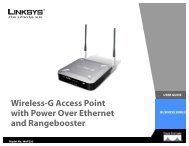Cisco Small Business RV 120W Wireless-N VPN Firewall ...
Cisco Small Business RV 120W Wireless-N VPN Firewall ...
Cisco Small Business RV 120W Wireless-N VPN Firewall ...
You also want an ePaper? Increase the reach of your titles
YUMPU automatically turns print PDFs into web optimized ePapers that Google loves.
Configuring the <strong>Firewall</strong>Configuring Port Triggering4Configuring Port TriggeringPort triggering allows devices on the LAN to request one or more ports to beforwarded to them. Port triggering waits for an outbound request from the LAN onone of the defined outgoing ports, and then opens an incoming port for thatspecified type of traffic. Port triggering is a form of dynamic port forwarding whilean application is transmitting data over the opened outgoing or incoming ports.Port triggering opens an incoming port for a specific type of traffic on a definedoutgoing port.Port triggering is more flexible than static port forwarding (available whenconfiguring firewall rules) because a rule does not have to reference a specificLAN IP or IP range. Ports are also not left open when not in use, thereby providinga level of security that port forwarding does not offer.NOTE Port triggering is not appropriate for servers on the LAN, since there is adependency on the LAN device making an outgoing connection before incomingports are opened.Some applications require that, when external devices connect to them, theyreceive data on a specific port or range of ports in order to function properly. Therouter must send all incoming data for that application only on the required port orrange of ports. The gateway has a list of common applications and games withcorresponding outbound and inbound ports to open. You can also specify a porttriggering rule by defining the type of traffic (TCP or UDP) and the range ofincoming and outgoing ports to open when enabled.To add a port triggering rule:STEP 1STEP 2STEP 3STEP 4STEP 5STEP 6Choose <strong>Firewall</strong> > Port Triggering.Click Add.Specify an easily-identifiable name for this rule.Check the Enable box to enable the rule.Select whether the port uses TCP, UDP, or both protocols.In the Outgoing (Trigger) Port Range section, specify the port number or range ofport numbers that will trigger this rule when a connection request from outgoing<strong>Cisco</strong> <strong>RV</strong><strong>120W</strong> Administration Guide 75
















